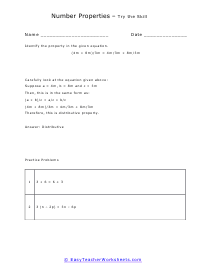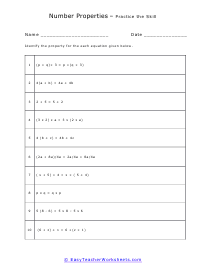There are generally five properties that apply to all integers. You must know all of them to solve the problems of advanced math like algebra and calculus. Let's learn about each property. The distributive property is used when you run into parenthesis. It tells us to always attack the parenthesis first. Distributive Property - The third number, after two times additions will be equal to the sum of the number of times you have added the third number. For example; 5 × (7 + 2) = 45 or 5 × 7 + 5 × 2 = 45. We also run into the associative property which applies to both addition and multiplication. This basically tells us that if we are multiplying or adding numbers it does not matter how we group the operation because the final value will always be the same. Associative Property - With respect to addition - The sum of the three or more added numbers will be the same. No matter in what ways you have grouped the numbers. For example; 6 + (4 + 3) = 13 or (6 + 4) + 3 = 13. With respect to multiplication - The product will remain the same when you multiply three or more numbers together. No matter in what ways you have made a group of multiplied numbers. For example; 6 × (4 × 3) = 72 or (6 × 4) × 3 = 72.
The Commutative property of addition and multiplication tells us that we can swap numbers when they are undergoing addition or multiplication on both sides. Commutative Property - With respect to addition - the sum of two added numbers remains the same. No matter in which order you have added the numbers. For example; 3 + 5 = 8 or 5 + 3 = 8 With respect to multiplication - The multiplied answer will be the same after multiplying two numbers together. The order will also be the same in which you multiplied the numbers. For example; 3 × 5 = 15 or 5 × 3 = 15. Identity Property - With respect to addition - The of added numbers will be zero. For example; 12 + 0 = 12 You will multiply the given number with one and the get the answer that is 18 × 1 = 18. These worksheets explain commutative, associative, and distributive number properties used to identify formulas and equations. Students will be asked to label given examples.













